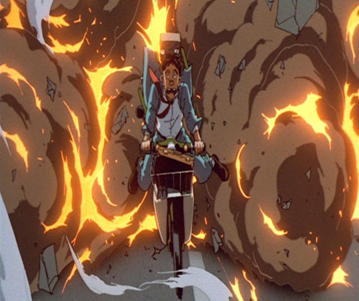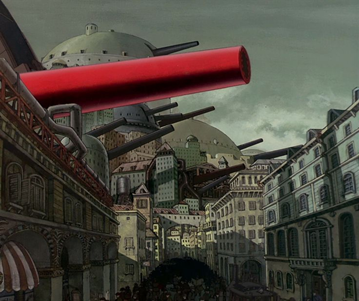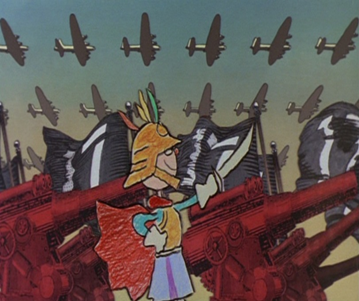
So, I participated in the anime secret santa event organized by the fellows at Reverse Thieves, and got three very well-regarded and technically accomplished anime films as recommendations: Memories, Lupin: Castle of Cagliostro, and Redline. While I’d plan to watch all three at some point, the eventual choice for a review is an easy decision. I love humane drama with sci-fi elements, and Memories is one I had been meaning to see for a while, so the rec has essentially become the final push for me.
Unsurprisingly, I came away from it feeling pretty darn satisfied and impressed.

Katsuhiro Ootomo of Akira fame had assembled a formidable crew for this project, with himself, Tensai Okamura, and Morimoto Kouji directing each of the segment, backed by a list of writing, animation, and musical talents that have since went on and had staggering accomplishments in the industry (among others, idiosyncratic animator Mitsuo Iso, anime’s most popular composer Yoko Kanno, and one of my favorite film directors and writers of all time, Satoshi Kon). While I was familiar with the reputation and basic concept of Memories as three-in-one anthology piece, I knew very little beforehand about the narrative details in any of the three stories. That made the whole experience even more tantalizing, as each story (especially Magnetic Rose) doesn’t reveal its true nature straight away and feels remarkably distinct from each other, tackling some pretty heavy themes in varying tone and manner of execution.
Here’s my take on each segment (I should note here that it’s relatively spoiler-y, as I described some narrative events and my impression of them in details):

In Space, No One Can Hear You Sing (Magnetic Rose)
Magnetic Rose is the clear main showcase, as well as the one that most explicitly embodies the anthology’s title in its theming. This one has a great atmosphere, boasting a well-paced mystery plot, nice bits of hard sci-fi details, a wonderfully intricate setting courtesy of Satoshi Kon (who, in addition to script, is responsible for background art and layout), and a sense of dangerous beauty as the characters work their way from one impressive visual set-piece to the next. Not least of which, it has amazing work from the sound department. The ridiculously prolific Shizuo Kurahashi is in charge of sound effects, and along with Yoko Kanno’s music, conjures a powerful soundscape that adds so much to the experience. There’s a lot of stand-out moments from the audio perspective, including the foreboding tune as the space crew wonder about the SOS they’re getting, the sickening squishy sound as the body of a certain little girl hit the floor, the chaotic frenzy of crumbling reality, and the opera grandeur to go along with a glorious climax that completely refuse to pull its punches.
In terms of narrative set-up, it’s a variation to the basic premise of ‘group of dudes stumble into something mysterious, end up biting way more than they can chew’, but in execution it ends up becoming much more than your typical survival horror story. In just his second full screenwriting credit (the first being for Otomo’s live action film World Apartment Horror), Kon already brought forth many pet themes that would pop up in his later feature films: the thin line between fantasy and reality, the malleable nature of memories, and a depiction of successful female performer past her prime. While I may have guessed the whole deal around the halfway point, there’s still a lot to admire from the screenplay and storyboard, from the effective establishment of the space garbage crew through the first few minutes of solid interplay, to the playful destabilization of perspective as hologram objects, flashbacks, and other forms of visual misdirection are thrown the audience’s way.
For all his heady concepts and visual pomp though, Kon’s sharp and earnest examination of human emotion is what I actually admire from him the most (there’s a good reason why Tokyo Godfathers is still a darn good movie despite lacking his usual fantastical elements, after all), and it ultimately also characterized this story for me. Magnetic Rose is a confirmation of human tendency to be shackled by the ephemeral, but after a gut-wrenching denouement, it also climaxes in a line that represents a defiant rejection of artificial heaven.
…speaking about difficulty to let go, this segment reminds me again of the fact that I will always be bummed about Kon’s premature passing and how it’s no longer possible to see more of his vision and singular talent. Moving on…

Stop Worrying, Love the Skunk (Stink Bomb)
After the heavy and ultimately depressing Magnetic Rose, Stink Bomb sure is some change of pace. I have fun with this one, which I guess sounds pretty morbid considering that it had literally thousands of people dying. Thing is, it’s basically a practical joke, one that comes with jet black coating and snarky doses of political and military shenanigans. Storyboarding is an area of expertise for Stink Bomb director Tensai Okamura, and among the many great shows that he had storyboarded, I can see similar flow and warped sense of humor in Samurai Champloo (particularly the purely comedic episodes) that could be traced back to this segment. A flu-addled medical lab grunt made a simple mistake (i just knew what’s going to happen once the co-worker told him to grab the “….blue pill in the red case.”), and the narrative can’t be more gleeful in depicting the catastrophic mess that ensued, as well as Japanese officials being embarrassingly inept and Americans doing their usual American thing to swoop in and save the day… or maybe not.
Again, sound is important here, with Jun Miyake’s music characterizing the farcical nature of this segment and cluing in the audience that the tongue is indeed lodged firmly in cheek. A main tune called ‘Nobuo’s Groove’ stands out in particular, providing an impish accompaniment to our hapless ‘hero’ as he becomes a smelly death machine. On the visual front, while Stink Bomb lacks the staggering flair of the first and third segments, it’s still a well-animated affair rife with comical explosion and exaggerated facial design—courtesy of future sakuga factory Madhouse.
The joke is perhaps dragged a bit too long and I could see some not finding it funny at all, but I enjoy this, and it has a killer closing gag to boot.

Life, It Taught Me to Die (Cannon Fodder)
I had thought that the kid character in this is a robot, which had me excited since I love robot story, but apparently it’s just the art style making him look like one to me. Anyhow, this is the shortest segment and the most different in regards of narrative structure: instead of being a complete narrative like the other two, it’s largely allegorical glimpse of a single day in a certain world and society. And what a world it is! With European-style aesthetic brought to life by Studio 4C, it combines steampunk design elements with aspects of historical imperialism to create a well-fleshed and striking setting in its own grimy way, with imagery of jutting cannon mouths dominating the cityscape and significant time dedicated to meticulous cannon-loading sequence.
Visual world-building is the forte of this segment, with Otomo’s (writing and directing for this one) showmanship shining through seamless transitional cuts that create the illusion of a single continuous camera take. The approach highlights numerous corners etched with weariness, mechanical routine, and hollow nationalism, and it’s a world that I certainly wouldn’t mind to see more of beyond its 21-minute runtime.
There is next to nothing plot in Cannon Fodder, but the collection of strong imagery already tell their own story. The stand-out moment for me is late in the segment when the kid, with his bright red helmet and a rather enviable sense of innocence, asked the most important of questions: who exactly are they fighting against with all these cannons? His father’s classic put-down in response tells it all, and as the boy slinks away to his bed wishing that he’ll someday become a glorious commander instead of lowly cannon loader like his old man, we are shown his drawing being animated into an endearingly simple and childlike vision of this whole cannon-firing business. Great closing sequence to this segment, and to the anthology as a whole.

On level of artistry and craft alone, Memories should be considered as one of the most important anime films of all time. While I haven’t watched many anthology anime, it also felt to me like an ideal example of the format: not overloaded with content and not significantly uneven, it’s a trio of very well-executed shorts that complement each other quite well and showcase the kind of versatility in art style, narrative approach, and cinematography that the medium’s really capable of. Magnetic Rose is the segment that would appeal the most to majority of audience, and while the intentionally ridiculous staging of Stink Bomb and the lack of plot in Cannon Fodder may be off-putting to some, I certainly enjoy what they bring to the table as well. Memories is a great choice to get someone into anime for the first time, or perhaps more aptly, refresh those jaded by the apparent homogeneity in the current landscape.
Merry Christmas to all who celebrate!
[…] Memories as recommended […]
LikeLike
[…] bloggers, and post about a show/film recommended to you by Christmas). Last year, I wrote about Katsuhiro Ootomo’s sci-fi anthology film Memories, and this time… I’m doing another sci-fi film. HAL was recommended to me on the basis that […]
LikeLike
Very interesting review. It’s been a long time since I’ve seen that movie.
LikeLike